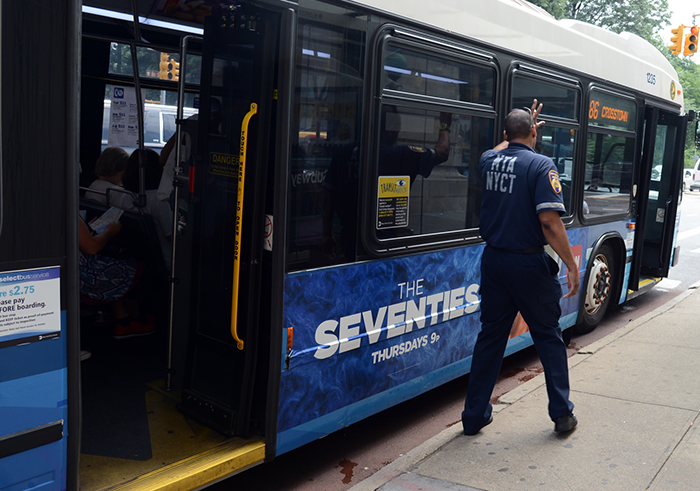Photo Courtesy of MTA/Marc A. Hermann
According to Comptroller Stringer, the MTA bus system has failed to keep up with changing geography of NYC’s economy, with routes that are meandering and disconnected from new jobs centers.
By Forum Staff
In the last eight years alone, the Metropolitan Transportation Authority bus system has lost 100 million passenger trips while buses traveled at the slowest speeds in the country among large cities, according to a scathing new report released on Monday by Comptroller Scott Stringer.
According to “The Other Transit Crisis: How to Improve NYC’s Bus System,” the decline in ridership “is not surprising, given routes that are often slow, unreliable, long, meandering, confusing, congested, and poorly connected.” Additionally, the analysis also found that the rapid decline in the city’s bus service over the last decade disproportionately impacts immigrant and lower-income New Yorkers, since they make up the highest share of bus riders in the five boroughs.
The report’s findings include:
MTA buses are now the slowest in the nation among large cities. In fact, bus service can often be slower than walking speed
• The average New York City Transit bus travels a dismal 7.4 miles per hour along its local, Select Bus Service, and express routes – slowest among the 17 largest bus companies in the nation.
• The typical city bus spends only half its time in-motion/in-traffic. Another 21 percent is spent at red lights and 22 percent at bus stops.
• Average bus speeds vary dramatically among the boroughs, with the slowest average speeds in Manhattan (5.5 mph), Brooklyn (6.3 mph), and the Bronx (6.5 mph). This is significantly lower than local routes in Queens (8.1 mph) and Staten Island (11.4 mph).
As service has deteriorated, ridership has plummeted
• The MTA bus system has lost 100 million passenger trips in the last eight years. That decline is most prevalent in Manhattan, where ridership is down 16 percent since 2011, and Brooklyn, which has seen a four percent decline over the same time period.
This decline is happening at a time when NYC’s economy – and commuting patterns – are changing, with increased job growth outside of Manhattan that necessitates new route
• NYC subways were largely built to bring workers to Manhattan. But residents of every borough are now more likely to commute within their home borough rather than to Manhattan, making an efficient, well-planned bus system even more important.
• From 2006 to 2016, the number of jobs located in Brooklyn jumped by 49 percent, in the Bronx by 35 percent, in Queens by 34 percent, and in Staten Island by 27 percent – but only 5 percent in Manhattan. As a result, the share of city jobs located outside of Manhattan rose from 35 percent to 42 percent over this period.
• The changing jobs geography means residents of every borough are now more likely to commute within their home borough than to Manhattan.
As new employment centers emerge outside of Manhattan, the bus system has not kept pace
• Compared to the average city neighborhood, in total there are 12 neighborhoods (and two airports) that offer significantly more jobs but remain significantly underserved by bus and subway service.
• Neighborhoods like Williamsburg, Morris Park, Norwood, Greenpoint, Glen Oaks, Red Hook, and the two Queens airports are among the top neighborhoods that remain underserved by a declining bus system.

